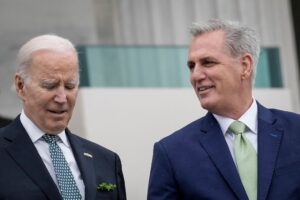President Joe Biden and House Speaker Kevin McCarthy (R-CA) shocked anyone who has not been following US politics since the last debt ceiling drama in 2021. The Democratic and Republican leaders announced the Fiscal Responsibility Act, a plan to raise the debt limit by a few trillion dollars and postpone another season of political theater until after the 2024 election. The GOP leadership celebrated because it trimmed spending with eyebrow scissors. At the same time, Biden participated in the extreme sport of standing up because his opponents folded faster than Superman on laundry day. A chorus of fiscal conservatives says the taxpayers lost. Is it time to retire America’s mantra of “In God We Trust” and substitute it with “Whoever wins, you lose”?
The Debt Ceiling Numbers
Of course, the major headline coming out of the Memorial Day holiday is that Republicans agreed to increase the debt ceiling by $4 trillion on top of the $31.4 trillion national debt already accrued. The debt limit will be suspended until January 2025. So, hot on the heels of the next presidential election, either Biden or the Republican nominee will face another fiscal fight. A growing number of GOP caucus members are visibly upset, citing the lack of substantive gains, as McCarthy and his team of negotiators achieved only about $50 billion in cuts, despite possessing immense leverage.
Rep. Byron Donalds (R-FL) estimated the agreement will reduce spending by about $12 billion this year. “Who here thinks it’s cool to cut $12 billion in exchange for $4 trillion?” he asked. “This bill actually keeps the Biden baseline intact for the federal agencies. The Republicans in Congress have been saying for months that we need to get back to pre-COVID spending levels. This bill canonizes post-COVID spending levels brought to us by Joe Biden and the Democrats. This bill keeps all of Joe Biden’s policies, all of Joe Biden’s spending intact.”
This type of deal was widely expected, even with the Republicans passing the Limit, Save, Grow Act in April. But why does it have to be this way? Well, for a couple of reasons, unfortunately.
The first is that the party that bills itself as a group of fiscal conservatives has yet to accomplish much during these tiffs. Former President George W. Bush put two wars and his expansion of the federal government on Uncle Sam’s credit card. Many critics assert that former House Speaker Paul Ryan’s sequester in the Obama years was laughable. Former President Donald Trump and his Republicans demanded to raise the debt ceiling automatically.

Joe Biden and Kevin McCarthy (Photo by Drew Angerer/Getty Images)
The second is the way the budget has been constructed over the past few decades. Approximately two-thirds of the federal budget consists of mandatory spending. This includes Social Security, veterans’ benefits, income security programs, major healthcare programs, and much more. Put simply, more than $4 trillion will automatically be spent and increased every fiscal year. This leaves $2 to $3 trillion in discretionary and supplemental spending to be debated by the smartest men and women in the nation today. So, under the Fiscal Responsibility Act, for example, McCarthy kept non-defense spending at $637 billion in FY 2024 and negotiated a 1% boost in the following year. After 2026, the budget caps would be scrapped. Or, as another instance, officials rescinded $30 billion from COVID-19 relief packages, which amounts to a rounding error in the annual pecuniary monstrosity.
To put this into perspective, the $50 billion in savings would cover about two months of interest payments. This year alone, the federal government is forecast to pay about $600 billion in interest to service the country’s debt. By 2033, the president’s budget predicts that cumulative interest payments will exceed $3 trillion. So, the $50 billion will cover just 1%.
The Debt Can
In the end, the Fiscal Responsibility Act kicks the can down the never-ending road. The agreement allows both sides of the aisle to delay taking action for another 18 months. Then, once January 2025 comes, the elephants and donkeys will showboat in front of the cameras again. With days until the Treasury’s extraordinary measures are exhausted, they will reach a deal to raise the debt limit. Rinse, cycle, debt, repeat. This is life in Washington. There is a reason why the financial markets do not experience a meltdown when debt ceiling season arrives. They know better than to fall for the mendacity.
All opinions expressed are those of the author and do not necessarily represent those of Liberty Nation.
Do you have an opinion about this article? We’d love to hear it! If you send your comments to [email protected], we might even publish your edited remarks in our new feature, LN Readers Speak Out. Remember to include the title of the article along with your name, city, and state.
Please respect our republishing guidelines. Republication permission does not equal site endorsement. Click here

